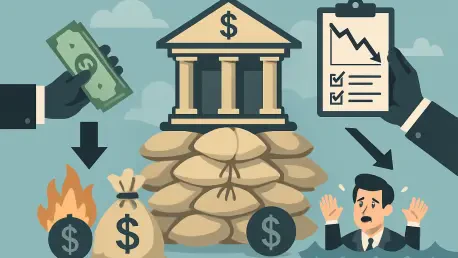A staggering $178 million loss tied to a single subprime auto lender has sent shockwaves through the U.S. banking sector, prompting regional giants like Fifth Third to sound the alarm on vulnerabilities in non-depository financial institution (NDFI) lending. This isn’t just a number on a balance sheet—it’s a glaring warning of risks lurking in a niche but dangerous corner of the credit market. As fraud allegations surface and investor confidence wavers, the industry finds itself grappling with questions of oversight and exposure. What does this mean for the stability of regional banks, and how deep do these risks run?
The importance of this issue cannot be overstated. NDFI lending, though a small fraction of many banks’ portfolios, has become a lightning rod for concern amid tightening credit conditions and heightened market scrutiny. With Truist and others reporting similar exposures, the ripple effects are evident in stock sell-offs and analyst warnings. This story isn’t just about isolated losses; it’s about the potential for systemic cracks in a sector already navigating economic headwinds. The stakes are high for investors, regulators, and everyday consumers whose financial security ties back to these institutions.
Unpacking the Threat: Why Nonbank Lending Alarms Banks
Delving into the heart of this financial unease reveals why NDFI lending has emerged as a pressing concern. These non-depository entities, often operating outside traditional banking regulations, play a critical role in extending credit, particularly in sectors like subprime auto loans. For regional banks like Fifth Third and Truist, where NDFI exposure accounts for 8% and 11% of portfolios respectively, even small disruptions can have outsized impacts compared to megabanks with broader diversification.
The broader economic landscape amplifies these worries. With credit conditions tightening in 2025, banks face increasing pressure to manage risk while maintaining profitability. Investors, already jittery from recent market volatility, are quick to react to any sign of weakness, especially in regional players perceived as less resilient. This dynamic creates a feedback loop of concern, where isolated incidents fuel broader fears about credit quality across the industry.
The Rising Concern: Nonbank Lending’s Impact on Banking
Beyond the immediate portfolio percentages, the focus on NDFI lending stems from its potential to act as a canary in the coal mine for wider credit issues. Unlike traditional loans, these arrangements often involve complex structures and less regulatory oversight, making them harder to monitor. For regional banks, which lack the capital buffers of larger peers, a single bad bet can erode trust and trigger significant financial strain.
This vulnerability ties into a larger narrative of economic uncertainty. As borrowing costs rise and consumer defaults tick upward, the spotlight on nonbank lending intensifies. Stakeholders, from shareholders to small business owners reliant on bank credit, are left questioning whether these risks are isolated or indicative of deeper structural flaws. The anxiety is palpable, setting the stage for a closer look at specific failures driving this conversation.
Key Incidents: Financial Hits and Market Fallout from NDFI Lending
Turning to concrete examples, the scale of recent losses paints a stark picture. Fifth Third’s $178 million charge-off linked to subprime auto lender Tricolor stands out as a major blow, compounded by JPMorgan Chase’s $170 million hit from the same entity. Meanwhile, Truist and U.S. Bank have flagged exposures to auto parts maker First Brands, adding to the growing list of problem loans in this space.
Fraud allegations deepen the crisis narrative. Fifth Third has pointed to “clear fraud” in the Tricolor case, alleging deliberate external misconduct. This isn’t an isolated claim—similar concerns echo across other institutions, fueling investor panic. The market reaction has been swift, with regional bank stocks facing sell-offs as generalist investors flee perceived risks. JPMorgan CEO Jamie Dimon’s metaphor of “cockroaches” captures the fear perfectly: one visible issue might hint at many more hidden beneath the surface.
These incidents aren’t just financial—they’re psychological. The uncertainty they breed ripples through earnings calls and boardrooms, prompting questions about how much is truly known about NDFI portfolios. Each new disclosure adds fuel to the fire, challenging banks to prove their losses are contained rather than systemic.
Industry Insights: Bank Leaders and Analysts Weigh In
Voices from within the industry provide a mix of reassurance and skepticism. Fifth Third’s leadership has framed the Tricolor loss as a one-off, emphasizing a thorough review of their asset-backed finance holdings to prevent recurrence. Truist CEO Bill Rogers echoes this sentiment, calling recent issues uncorrelated and not reflective of broader trends, while U.S. Bank’s Gunjan Kedia stands by the strength of current underwriting practices.
Analysts, however, aren’t as convinced. UBS’s Nicholas Holowko points to the market’s near-obsession with NDFI risks, noting how quickly sentiment can shift. Similarly, TD Cowen’s Steven Alexopoulos warns that investor focus remains fixated on potential hidden problems, regardless of executive assurances. This disconnect between bank optimism and external doubt underscores a critical tension, as trust hangs in the balance.
The dialogue reveals a sector at odds with itself. While leaders strive to project control, the undercurrent of concern among analysts suggests that regaining market confidence will require more than words. Transparency and tangible action are becoming non-negotiable as scrutiny mounts.
Risk Mitigation: How Banks Can Weather the NDFI Challenge
Amid these challenges, actionable strategies are emerging to address NDFI lending risks. Portfolio reviews, as undertaken by Fifth Third, offer a starting point, allowing banks to identify and isolate problem areas before they escalate. Strengthening underwriting standards is another priority, ensuring that future loans are vetted with greater rigor to avoid similar pitfalls.
Truist’s Chief Risk Officer Brad Bender has highlighted the role of robust loan-loss reserves in cushioning against unexpected hits. Beyond internal measures, proactive communication during earnings calls can help manage investor expectations, while continuous monitoring for fraud indicators—such as double pledging of collateral—adds a layer of defense. These steps collectively form a blueprint for resilience in an uncertain landscape.
Empowering banks with these tools is essential, but it’s not just about damage control. The industry must also foster a culture of vigilance, learning from each incident to refine risk management practices. Only through such adaptability can regional players hope to navigate the choppy waters of nonbank lending without capsizing under the weight of unforeseen losses.
Reflecting on the Path Forward
Looking back, the warnings from Fifth Third and Truist served as a critical wake-up call for the banking sector. The substantial losses and fraud allegations tied to NDFI lending exposed vulnerabilities that many had underestimated. These events forced a reckoning, pushing institutions to confront the gaps in oversight and risk assessment that allowed such issues to fester.
Moving ahead, the focus shifted toward building stronger safeguards. Banks began prioritizing transparency, sharing detailed exposure data to rebuild trust with investors. Enhanced monitoring systems were rolled out to catch early warning signs, while partnerships with regulators aimed to close loopholes in nonbank lending oversight. These steps, though challenging, laid the groundwork for a more resilient industry, determined to prevent past missteps from defining its future.









